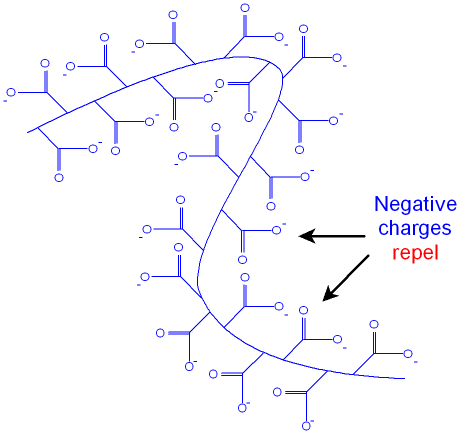1. Styrofoam is able to dissolve in acetone because acetone is a good solvent for polystyrene, which is what styrofoam is made of. After the acetone has evaporated, what’s left is a very solid and dense styrofoam. This is because styrofoam is made with foaming agents, which means that it contains lots of air pockets. These air pockets then get expelled out of the styrofoam when it is put inside the acetone.
2a) The monomers that form up the LDPE structure are highly branched thus they will not be able to form crystalline structures as well as HDPE. This results in weaker intermolecular forces of attraction as the london dispersion force between molecules is reduced as compared to that of HDPE. Tensile strength of LDPE is therefore lower making it less resistant to cuts, hence its unsuitability.
b) The molecules of HDPE are packed closely in a linear fashion that consist of stronger instantaneous dipole- induced dipole attractions between molecules and thus stronger inter molecular forces. This allows the polymer to have the required strength and toughness. Therefore, using a thin liner of HDPE allows room for flexibility.
3. The molecular structure of certain plastic is the reason why these plastic can be stretched to a certain extent. Plastic bags are polymers. Strong covalent bonds are present between the atoms. Lots of energy are required to overcome these bonds. However the reason why certain plastic can be stretched is not due to these covalent bonds but the cross-linkage between the polymer chains. These chains are arranged in parallel. When forces are applied to it, the chains can slide pass each other, but this is only to a certain extent. On the other hand, paper do not have these structures thus unable to be stretched.
a) The four properties are
1. non-toxicity
2. stable overtime of intended use
3. lack of reactivity and solubility in body fluid
4. Corrosion and wear resistance
b) Contact lenses are made from poly(methyl methacrylate) PMMA and hydrogels. The desirable properties in these materials include
1. transparency
2. some flexibility
3. oxygen permeability
4. unreactive to chemicals
5. hydrophilicity
6. low density
7. non-toxicity
8. suitable refractive index for bending of light rays
9. ease to insert, remove, clean and store.
c) Soft contacts are made up of pliable hydrophilic (“water-loving”) plastics called hydrogels. Hydrogels absorb significant amounts of water to keep the lenses soft and supple. New soft contact lenses called silicone hydrogel lenses, includes silicone within the hydrogel material to increase the oxygen transmissibility of the lenses.

Figure : Structure of hydrogels
Taken from: http://www.gcsescience.com/o70.htm

Figure : Structure of silicone hydrogel
Taken from: http://www.google.com/patents/US20120218509
Gas permeable contacts, also called GP or RGP lenses, are rigid (hard) contact lenses. Like hydrogels used for soft lenses, materials used to create GP contact lenses also are “gas permeable,” allowing oxygen to pass through the lenses to the cornea. Unlike soft lenses, however, rigid gas permeable lenses do not contain significant amounts of water. Instead, GP lenses rely on their microscopically porous nature to transmit oxygen to the cornea. Today’s fluoro-silicone/acrylate GP lenses are optimized for oxygen permeability, lens stability and surface wetting characteristics.

Figure : Structure of fluoro-silicone/acrylate
Taken from: http://www.google.com/patents/US20100331507
Because of their hardness and because they do not fluctuate significantly in their water content, gas permeable contacts generally have superior optical characteristics and provide sharper vision than soft lenses. However, despite advances in GP lens technology, some people cannot adapt to wearing rigid GP lenses and choose soft lenses for comfort reasons. “Hard” contact lenses, hence is harder to wear compared to the “Soft” contact lenses.
Gary Heiting, August 2016. What Are Contact Made Of? Taken from: http://www.allaboutvision.com/contacts/faq/contact-materials.htm

